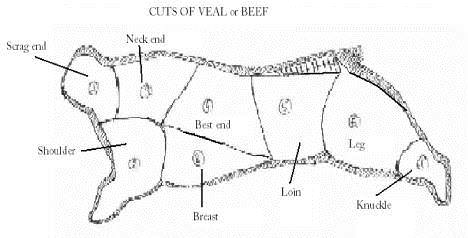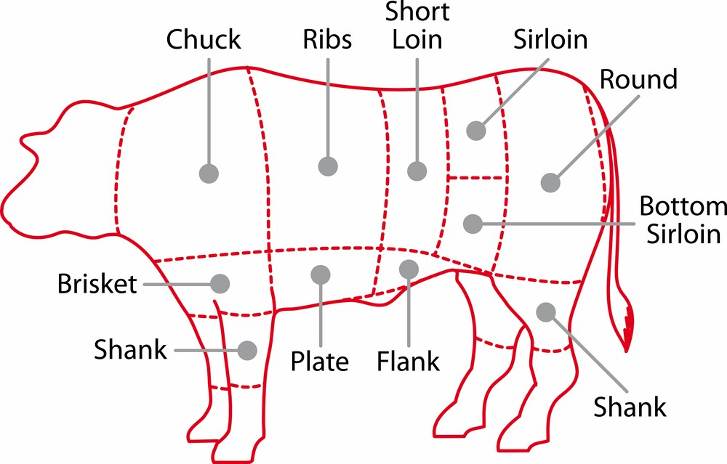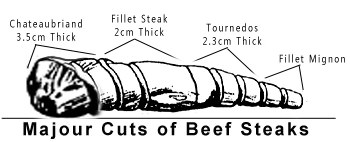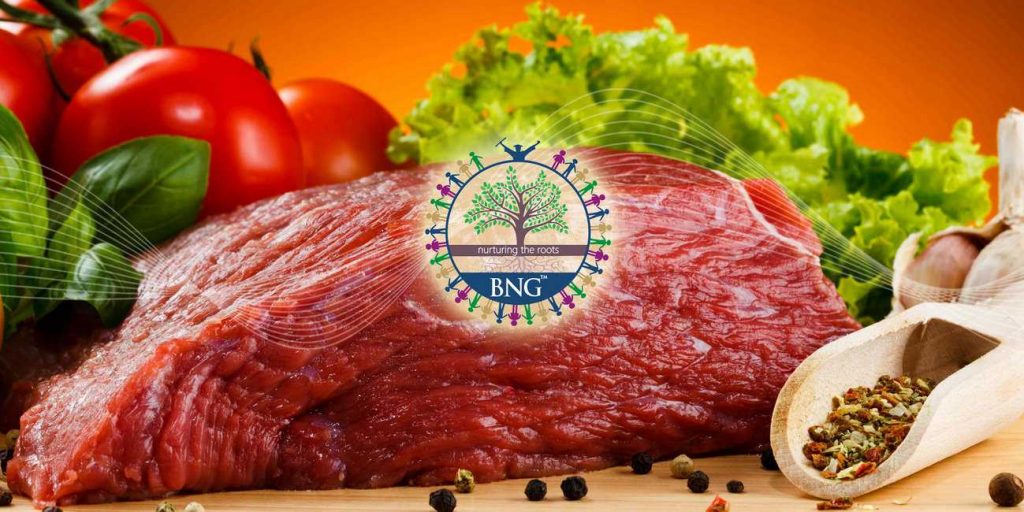Beef and Veal
Beef is the meat from bovines, especially domestic cattle. Fresh beef has cream-colored fat and bright red meat. The best beef is marbled with fine strands of fat, which bastes the meat as it cooks and makes it tender and juicy.

Veal comes from young calves, and so the meat is tender and lean and the flavor is delicate. The best way to cook veal is with moist heat, either by braising it or cooking it in a liquid. Since the meat is lean, it tends to dry out when cooked with dry heat. When selecting veal, check to make sure that the meat is moist and light pink-gray in color, that the fat is white, and that the bones are engorged with blood.
Terms Used in Beef Industry
Carcass: Whole animal after dressing from the slaughter house.
Side: A carcass that has been split down the center of the spinal column.
Quarter: A side that has been sub-divided into two sections as forequarters-hindquarters.
Crop: Fore quarters minus the plate, brisket and shin
Baron: A complete back (uncut) which is a pair of sirloins undivided.
Offals: Product derived from the process of slaughtering other than the carcass, the edible internal organs e.g. liver, heart, sweet bread, head, tongue, tail, brains, kidneys.
Cuts of Beef
Neck: This is one of the tougher cuts and is generally sold as Stewing Steak or made into mince (ground) meat. When sold in pieces, it is only suitable for very long, slow, moist cooking.

Blade and Chuck: This cut is often sold as Braising Steak. A little more tender than stewing steak. Use in casseroles, stews and to braise.
Fore Rib: Sometimes sold boned and rolled but is traditionally sold on the bone. Has a higher fat content throughout the flesh and makes a superb roast. Can also be cut into steaks for grilling or frying.
Thick Rib: This cut is often sold as Braising Steak. A little more tender than stewing steak. Use in casseroles, stews and to braise.
Thin Rib: This is one of the tougher cuts and is generally sold as mince (ground) meat.
Brisket: Often sold boned and rolled and sometimes salted. Suitable for slow or pot roasting. Traditionally used for aking corned beef.
Shin: This is one of the tougher cuts and is generally sold as Stewing Steak or made into mince (ground) meat. When sold in pieces it is only suitable for very long, slow, moist cooking.
Sirloin: Often sold boned and rolled. A prime cut which is suitable for roasting.
Sirloin Steak: Comes from the same area as sirloin but cut into steaks such as “T”-bone, Porterhouse and Entrecote. A prime cut which is suitable for grilling, frying, stir- fries and barbecuing.
ThinFlank: Often used for minced or ground meat. Suitable for cottage pie, Bolognese sauce and burgers. Thin flank is also known as Top Rump. Similar to topside and can be slow roasted as a joint or slow fried or braised in pieces. Also sold as “flash fry” steaks.
Leg: This is one of the tougher cuts and is generally sold as Stewing Steak. Only suitable for very long, slow, moist cooking.
Silverside: Although this was traditionally salted and sold as a boiling joint, this very lean piece of meat is now most often sold unsalted as a joint for roasting. Requires frequent basting through the cooking time.
Topside:Very lean and when sold as a joint for roasting, often has a layer of fat tied around it to help baste and keep it moist. Also suitable cut into steaks for frying or grilling and in stir-fries.
Rump: Although a prime cut, it is usually cheaper than fillet or sirloin because it’s not quite as tender. Suitable for quick cooking e.g. frying, stir-fries, grilling or barbecuing.
Shank: This is one of the tougher cuts and is generally soldas mince (ground) meat
Steaks

A steak is a slice from a larger piece of meat typically from beef. Most steaks are cut perpendicular to the muscle fibres, improving the perceived tenderness of the meat. A restaurant that specializes in beef steaks is known as a steakhouse. A typical steak dinner consists of a steak, with a starchy side dish, usually baked potatoes, but occasionally another potato dish, rice, pasta, or beans. In France, beef steak is usually served with French fried potatoes also known as “pommes frites”, and the combination is known as steak-fries”. The different types of beef steaks are given below:
- Chateaubriand steak – Usually served for two, cut from the large head of the tenderloin.
- Chuck steak – A cut from neck to the ribs.
- Cube steak – A cut of meat, usually top round, tenderized by a fierce pounding of a mallet.
- Filet mignon – A small choice tenderloin, the most tender cut, less flavorful.
- Flank steak – From the underside. Not as tender as steaks cut from the rib or loin.
- Flat iron steak – A cut from the shoulder blade.
- Hanger steak or (French) onglet – A steak from near the center of the diaphragm. Flavorful, and very tender towards the edges; but sinewy in the middle. Often called the “butcher’s tenderloin.”
Popular seak cuts of North Americans are Proster house steak, New York steak, Sirloin steak, T-bone steak, round steak, rump steak, etc. Depending on the extent of cooking, finished product is called rare, medium or well done.
BEEF/VEAL:
Beef and veal are classified by their ages.
Veal: – Flesh of calf (less than 3 months of age) which lives on milk stage.
Calves: – The animal reach 3-8 months old.
Beef: – If the animal is above 8 months, the fleshes are called beef flesh.
Beef is the most popular of all the edible meat in the western countries. In India beef is not very popular but the buffaloes presents in the menu. The age and sex has been an influence on the taste and the quality of the beef meat.
| Sl. No. | Name of cuts | Weight | |
| 01 | Scrag-end | 1 Ya kg. | |
| 02 | Neck-end | 4 kg. | |
| 03 | Best-end | 6 kg. | |
| 04 | Loin | 5 kg. | |
| 05 | Leg | 18 kg. | |
| 06 | Knuckle | Y kg | |
| 07 | Breast | 2 Y kg | |
| 08 | Shoulder | 5 kg. |
—





